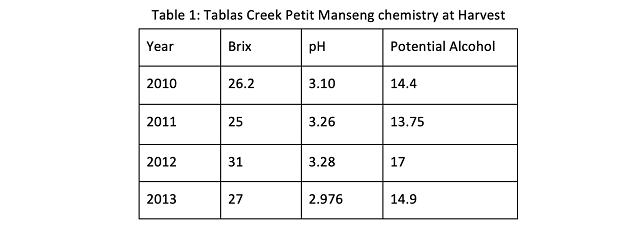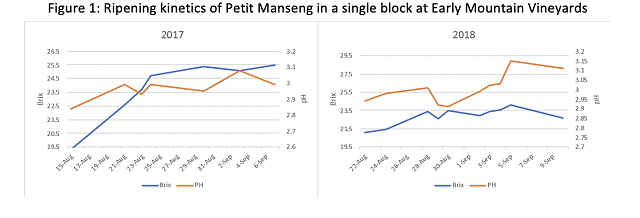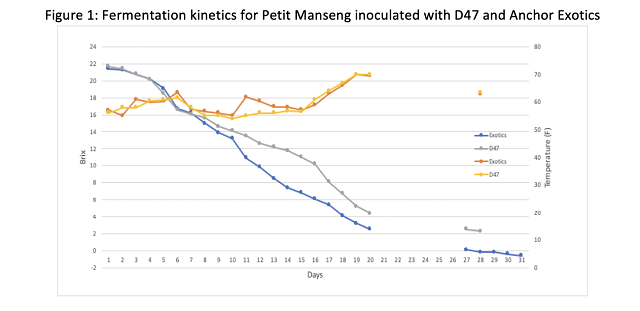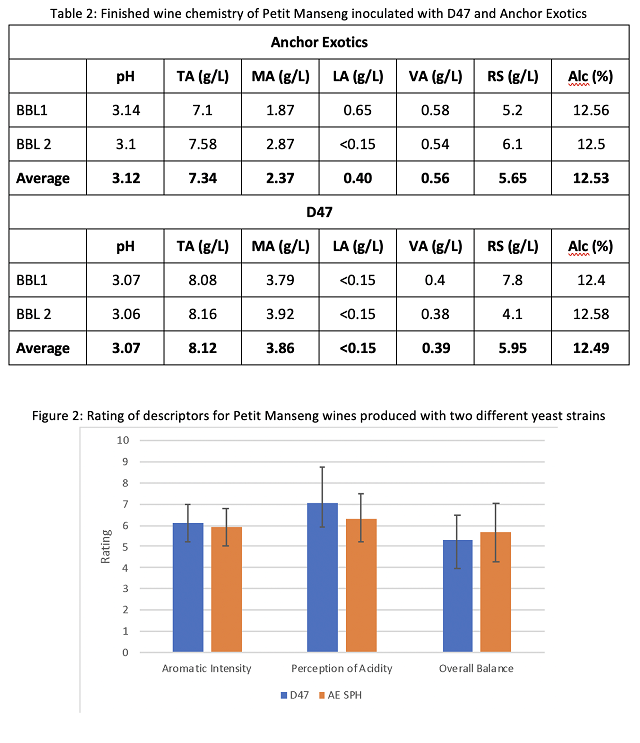Using yeast to de-acidify Petit Manseng (2018)
Matthieu Finot
King Family Vineyards
Summary
Petit Manseng is a white fruited variety of Vitis vinifera that originated in the Pyrenees-Atlantiques of Southern France and has its largest plantings in the Jurançon (Tablas Creek a). Petit Manseng was introduced to Virginia by Dr. Tony Wolf in 1987 and has become popular among producers for its loose clusters, thick skins, and resistance to bunch rots (Wolf 2008). In Virginia, a growing number of winemakers are exploring dry Petit Manseng as a varietal table wine, however, the high sugar and high acidity characteristic of this grape variety can be a challenge for dry wines. In the present study a side by side comparison was done of wines produced by Perlage yeast (Enartis) and ES401 yeast (Enartis). Perlage was chosen for its tolerance to low pH and high alcohol conditions, however it is known to delay the start of malolactic fermentation. ES401 has the ability to remove up to 25% of the malic acid in the juice during alchoholic fermentation and is thought to favor the start of malolactic fermentation. Three barrels were used in the experiment. The barrel inoculated with Perlage finished fermentation in 12 days while both barrels inoculated with ES401 did not fully complete alcoholic fermentation, leaving 4 g/L of residual sugar. Malolactic fermentation had not occurred in the unsulfured barrel inoculated with ES401. Wine inoculated with ES401 had 14% less malic acid than the wine inoculated with Perlage, however there was no significant difference in perception of acidity among tasters. Panelists were able to distinguish the two wines in a triangle test, however descriptors were inconclusive as to the nature of this difference.
Introduction
Petit Manseng is a white fruited variety of Vitis vinifera that originated in the Pyrenees-Atlantiques of Southern France and has its largest plantings in the Jurançon (Wolf 2008, Tablas Creek a). In its home region, it is most often made as an off dry or dessert wine, often blended with Gros Manseng. These wines are described as having unique fruity and spicy aromas such as pineapple, peach, melon, grapefruit, nutmeg, honey, wildflowers, box tree, and roasted coffee bean (Gardiner et al 2017). Notable levels of thiols (Tominaga et al 2000) and esters (Antalik et al 2014) have been measured in wines made from Petit manseng grapes and contribute to these descriptors.
Petit Manseng was introduced to Virginia by Dr. Tony Wolf in 1987 as part of vineyard variety trials and has become popular among grape growers for its loose clusters, thick skins, and resistance to bunch rots (Wolf 2008). In the last 30 years, popularity has grown such that Virginia now boasts the second largest planting of Petit Manseng in the world with more than 62 acres of Petit Manseng are planted around the state (Wood et al 2018).
In Virginia, a growing number of winemakers are exploring dry Petit Manseng as a varietal table wine, however, the high sugar and high acidity characteristic of this grape variety can be a challenge for dry wines. In a survey of past vintages, Tablas Creek surveyed brix and pH at harvest (Table 1). When potential alcohol is calculated with a conservative conversion rate of 0.55 degree/degree Brix, it is evident the wines produced from these grapes, if fermented to dryness could be out of balance.

Virginia has hot summers and occasional-to-frequent rain during the growing season, partially moderating the high alcohol and acidity of Petit Manseng. Early Mountain Vineyards provided Brix and pH measurement data from grape sampling for one block of Petit Manseng from 2017 (a relatively dry year) and 2018 (a wet year). In 2017 potential alcohol was substantial but did not exceed 15% while pH at harvest was near 3.1. The real appeal of the variety is seen in 2018, which demonstrates that this variety can accumulate high levels of sugar without steep increases in pH even with substantial rainfall (Figure 1).
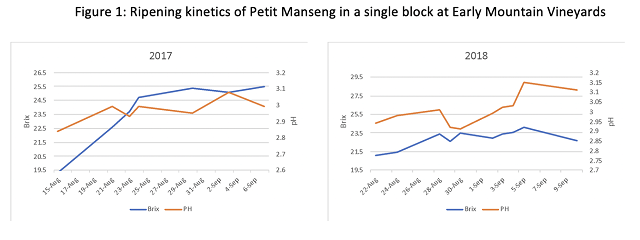
Several winemaking strategies have been explored to find a balance of acid and alcohol in Petit Manseng when fermented dry. Some winemakers have experimented with earlier harvest dates to reduce alcohol level and tame some of the aggressive aromatics Petit Manseng can present, however this must be balanced with acidity that may be very high with an early harvest. Skin contact prior to fermentation releases potassium that can precipitate tartaric acid and lead to lower acid wines, however this must be balanced with the introduction of phenolics that can be texturally apparent and can lead to early browning. Some have attempted malolactic fermentation, however high alcohol and high acidity are a challenging environment for O. oeni and can lead to high levels of volatile acidity. Aging the wine on yeast lees for an extended period of time (18 months) can lead to release of polysaccharides from yeast hulls that add roundness to the wine but can come with the added risk of VA accumulation during long aging.
Another option for balancing the acidity of Petit Manseng is the careful selection of yeast strains that consume acid during fermentation. Yeast have a variety of metabolic pathways in addition to those that convert sugar to alcohol. Some species and strains synthesize malic acid under specific conditions (Volschenk et al 2003) while others have cellular machinery to de-acidify their environment by metabolizing malic acid to lactic acid (Jackson 2014). Still others use the malo-ethanolic pathway to convert malic acid to pyruvate, an intermediate in the pathway that leads to alcohol production (Saayman and Viljoen-Bloom, 2006). The ability to metabolize malic acid to ethanol varies by strain and species with Saccharomyces cerevisiae, S. bayanus, and S. paradoxus are able to utilize this pathway in the presence of glucose (Saayman and Viljoen-Bloom, 2006).
The rate of malo-ethanolic conversion is limited due to cell transport and the location of the enzymes within the cell. Saccharomyces cells lack specific transport proteins for malic acid, so the rate of uptake from the juice is only as fast as diffusion will allow. The higher the malic acid concentration, the faster malic acid will be taken into the cell (Volschenk et al 2003). The enzymes responsible for converting malic acid to pyruvate (and ultimately to alcohol) are located in the mitochondria of the cell. Under fermentative conditions, few mitochondria are maintained. Those that are present are in a poorly developed state, leaving fewer enzymes available and slowing the conversion rate of malic acid (Volschenk et al 2003).
The ability of Saccharomyces to metabolize malic acid differs by species and strain. S. paradoxus has been shown to consume 28-38% of malic acid during fermentation while S. cerevisciae consumed 17% and S. bayanus consumed only 8% (Redzepovic et al 2003). These differences in rate were shown to be due to differences in gene expression. In S. paradoxus and S. cerevisciae, expression of these genes responsible for malic acid degradation increased toward end of fermentation while in S. bayanus gene expression decreased. In S. paradoxus, the rate of malic acid degradation increased as well, indicating this species can use malic acid as a secondary carbon source once glucose has been depleted. Within S. cerevisciae, strains will vary in ability to degrade malic acid; generally, wine producing strains are thought to be inefficient (Volschenk et al 2003).
In the present study, two yeast strains were compared for their ability to produce a balanced, dry Petit Manseng wine:
Perlage (Enartis) is a Saccharomyces cerevisciae bayanus yeast strain chosen for its ability to produce wines with “great aromatic finesse” and express “varietal character and terroir” under the challenging fermentation conditions brought on by Petit Manseng. This yeast is tolerant to low pH and high alcohol (
ES401 (Enartis) is a Saccharomyces cerevisciae strain whose fermentations are characterized by “very intense fresh fruit aromas”. This yeast also produces high amounts of glycerol and has the ability to remove up to 25% of the malic acid in juice during primary fermentation. It is also highly compatible with malolactic fermentation and is cited to “favor the start of MLF”. It has moderate alcohol tolerance (
Procedure
Petit Manseng grapes were harvested on 9/10 and refrigerated overnight before pressing on 9/11. Juice was cold settled and racked on 9/15. On 9/17 juice was subjected to reverse osmosis to achieve a 19% concentration, then racked to barrels of the same cooperage and age (Cadus ML Tight Grain French Oak, 2012). Juice analysis was completed after reverse osmosis. On 9/20 juice was inoculated with 14 g/hL yeast rehydrated in 0.2 g/hL Go Ferm Evolution according to manufacturer’s instructions. There were three treatments:
- Enartis Perlage
- Enartis ES401
- Enartis ES401 for malolactic fermentation
Fermentations were carried out in the barrel room (with an ambient temperature of approximately 60°F). Fermentation kinetics (brix and temperature) were monitored throughout fermentation.
Wine was treated with 25 g/hL of SO2 after the completion of alcoholic fermentation (treatments 1 and 2) or malolactic fermentation (treatment 3). Wine was stirred on lees beginning when the density was tested below a specific gravity of 1.0 and continued throughout aging.
Sensory analysis was completed by a panel of 28 wine producers. Wines were presented blind in randomly numbered glasses. Tasters were presented with three wines, two of one type and one of another, and asked to identify which wine was different (a triangle test). There were three tasting groups with the unique wine in the triangle test balanced between groups. Tasters were then asked to score each wine on a scale of 0 to 10 for aromatic intensity, perception of acidity and overall balance. Panelists were also given open ended questions to describe the wines. Results for the triangle test were analyzed using a one-tailed Z test. Descriptive scores were analyzed using repeated measures ANOVA.
Results

Juice chemistry prior to and following reverse osmosis can be found in Table 1. The barrel that was inoculated with Perlage completed fermentation (D =992) with 12 days (Figure 1). Neither of the barrels inoculated with ES401 fully completed fermentation. After 32 days they were still at D=994 and were allowed to continue to ferment until January with less frequent monitoring. In January, residual sugar was measured on both barrels and found to be 3.9 and 4.0 g/L. One barrel was treated with SO2 (Treatment 2, “ES401 No Malo”) while the other was left unsulfured to allow malolactic fermentation. At the time of the sensory session, no malolactic conversion was apparent, so only treatments 1 and 2 were tasted. Due to the difference in sugar between barrels, sugar was added back to the Perlage barrel sample at the time samples were taken for sensory analysis.
At the completion of fermentation, both barrels of ES401 had higher residual sugar than the Perlage barrel (4 vs 1.2) (Table 2). Fermentation conditions were within those recommended for Perlage (alcohol, temperature tolerance), however this yeast was not able to ferment this wine completely dry. The ES401 barrel that had not been treated with SO2 had higher VA, as is expected in an unprotected wine. Differences in free and total sulfur are consistent with cellar operations to date.
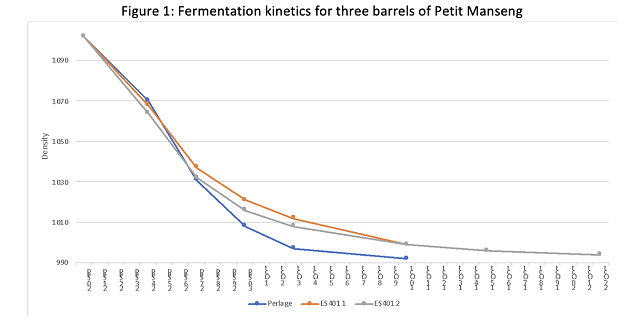
There appears to be no strong effect of yeast on pH or TA (Table 3). However, both barrels of ES401 have 0.35 g/L less malic acid than the barrel inoculated with Perlage, with no additional accumulation of lactic acid. This is a 14% reduction from the Perlage.
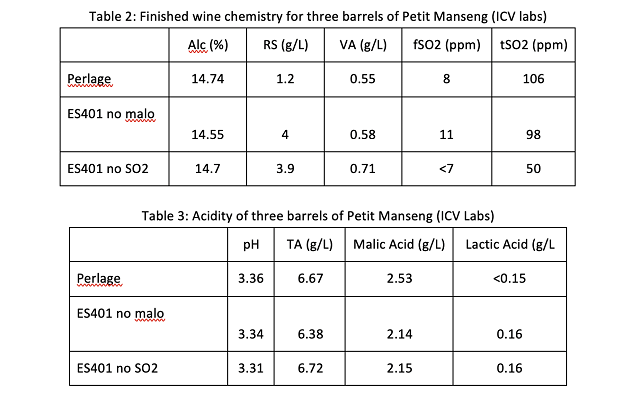
In a triangle test of wine fermented with Perlage and wine fermented with ES401, 20 out of 28 respondents were able to distinguish which wine was different, indicating the wines were significantly different (Z=4.08, p<0.001). There were no significant differences in scores for aromatic intensity, perception of acidity or overall balance (Figure 2). Open ended questions indicate no clear trends in what made these wines different. Discussion after the wines had been identified indicated a slight preference for Perlage but not strong trends in why this wine was preferred.
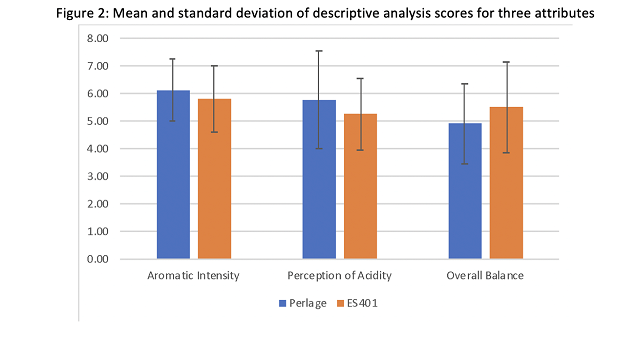
Conclusions
- Perlage inoculation resulted in a more complete fermentation, with residual sugar of 1.2 g/L while ES401 fermentation took longer and resulted in a wine with residual sugar of 4.0 g/L.
- Wine inoculated with ES401 had 14% less malic acid than wine inoculated with Perlage, with no large increase in lactic acid.
- ES401 inoculation did not result in malolactic fermentation during the time frame of this experiment.
- When presented with wine inoculated with Perlage vs. wine inoculated with ES401, panelists were able to distinguish the wine, however, the reason for the difference is unclear from the data. Descriptors for aromatic intensity, perception of acidity and overall balance were not significantly different and no clear trends were seen in open ended comments.
References
- Antalick G, M.C. Perello and G. de Revel (2014) Esters in wines: New insight through the establishment of a database of French wines. Am J Enol Vitic 65:293-304
- Gardner, D. M., S.E. Duncan, and B. W. Zoecklein (2017) Aroma Characterization of Petit Manseng Wines Using Sensory Consensus Training, SPME GC-MS, and Electronic Nose Analysis. Am. J. Enol. Vitic. 68(1): 112-119
- Enartis, Yeast Products, retrieved from https://www.enartis.com/en/products/yeast, October 10, 2019
- Jackson, R. S. (2014). Wine Science: Principles and Applications(4 edition). Amsterdam: Academic Press.
- Saayman, M and M. Viljoen-Bloom (2006) The Biochemistry of Malic Acid Metabolism by Wine Yeasts – A Review. S. Afr. J. Enol. Vitic. 27 (2): 113-122
- Tablas Creek Winery (n.d.) Petit Manseng: A Royal French Heritage and a New Life in the New World retrieved from https://tablascreek.typepad.com/tablas/2017/12/petit-manseng-a-royal-heritage-and-a-new-life-in-california.html October 5, 2019
- Tablas Creek Winery (n.d.) Wrapping Our Heads Around Petit Manseng retrieved from https://tablascreek.typepad.com/tablas/2016/03/wrapping-our-heads-around-petit-manseng.html, October 5, 2019
- Tominaga T, R. Baltenweck-Guyot, C. Peyrot Des Gachons and D. Du- Bourdieu (2000) Contribution of volatile thiols to the aromas of white wines made from several Vitis vinifera grape varieties. Am J Enol Vitic 51:178-181
- Volschenk, H., H.J.J. van vuuren, M. Viljoen-Bloom (2003) Malo-ethanolic fermentation in Saccharomyces and Schizoaccharomyces. Current Genetics 43: 379-391
- Wolf, T. K. (2008) Wine Grape and Rootstock Varieties. In T.K. Wolf (editor) Wine Grape Production Guide for Eastern North America (p37-70) Ithica, NY: Plant and Life Sciences Publishing.
- Wood, V., S. Custer, K. Watson, B. Chibbaro (2018) Virginia 2017 Commercial Grape Report retrieved from https://s3.amazonaws.com/vawine-production/articles/data/000/000/867/original/2017_Commerical_Grape_Report_FINAL_.pdf?1526493029, October 5, 2019

